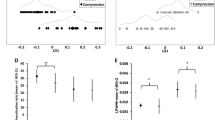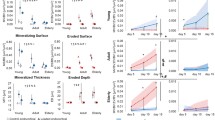Abstract
Mechanical stimuli are critical to the growth, maintenance, and repair of the skeleton. The adaptation of bone to mechanical forces has primarily been studied in cortical bone. As a result, the mechanisms of bone adaptation to mechanical forces are not well-understood in cancellous bone. Clinically, however, diseases such as osteoporosis primarily affect cancellous tissue and mechanical solutions could counteract cancellous bone loss. We previously developed an in vivo model in the rabbit to study cancellous functional adaptation by applying well-controlled mechanical loads to cancellous sites. In the rabbit, in vivo loading of the lateral aspect of the distal femoral condyle simulated the in vivo bone-implant environment and enhanced bone mass. Using animal-specific computational models and further in vivo experiments we demonstrate here that the number of loading cycles and loading duration modulate the cancellous response by increasing bone volume fraction and thickening trabeculae to reduce the strains experienced in the bone tissue with loading and stiffen the tissue in the loading direction.





Similar content being viewed by others
References
Aspenberg P, Goodman S, Toksvig-Larsen S, Ryd L, Albrektsson T. Intermittent micromotion inhibits bone ingrowth. Titanium implants in rabbits. Acta Orthop Scand. 1992;63:141–145.
Chambers TJ, Evans M, Gardner TN, Turner-Smith A, Chow JWM. Induction of bone formation in rat tail vertebrae by mechanical loading. Bone Miner. 1993;20:167–178.
Cullen DM, Smith RT, Akhter MP. Bone-loading response varies with strain magnitude and cycle number. J Appl Physiol. 2001;91:1971–1976.
Cullen DM, Smith RT, Akhter MP. Time course for bone formation with long-term external mechanical loading. J Appl Physiol. 2000;88:1943–1948.
De Souza RL, Matsuura M, Eckstein F, Rawlinson SC, Lanyon LE, Pitsillides AA. Non-invasive axial loading of mouse tibiae increases cortical bone formation and modifies trabecular organization: a new model to study cortical and cancellous compartments in a single loaded element. Bone. 2005;37:810–818.
Fritton JC, Myers ER, Wright TM, van der Meulen MC. Loading induces site-specific increases in mineral content assessed by microcomputed tomography of the mouse tibia. Bone. 2005;36:1030–1038.
Fritton JC, Myers ER, Wright TM, van der Meulen MC. Bone mass is preserved and cancellous architecture altered due to cyclic loading of the mouse tibia after orchidectomy. J Bone Miner Res. 2008;23:663–671.
Goldstein SA, Matthews LS, Kuhn JL, Hollister SJ. Trabecular bone remodeling: an experimental model. J. Biomech. 1991;24 Suppl 1:135–150.
Guldberg RE, Caldwell NJ, Guo XE, Goulet RW, Hollister SJ, Goldstein SA. Mechanical stimulation of tissue repair in the hydraulic bone chamber. J Bone Miner Res. 1997;12:1295–1302.
Guo XE, Eichler MJ, Takai E, Kim CH. Quantification of a rat tail vertebra model for trabecular bone adaptation studies. J Biomech. 2002;35:363–368.
Haapasalo H, Kontulainen S, Sievanen H, Kannus P, Jarvinen M, Vuori I. Exercise-induced bone gain is due to enlargement in bone size without a change in volumetric bone density: a peripheral quantitative computed tomography study of the upper arms of male tennis players. Bone. 2000;27:351–357.
Hert J, Liskova M, Landa J. Reaction of bone to mechanical stimuli Part 1 Continuous and intermittent loading of tibia in rabbit. Folia Morph, Prague. 1971;19:290–300.
Hollister SJ, Brennan JM, Kikuchi N. A homogenization sampling procedure for calculating trabecular bone effective stiffness and tissue level stress. J Biomech. 1994;27:433–444.
Hollister SJ, Guldberg RE, Kuelske CL, Caldwell NJ, Richards M, Goldstein SA. Relative effects of wound healing and mechanical stimulus on early bone response to porous-coated implants. J Orthop Res. 1996;14:654–662.
Lanyon LE, Rubin CT. Static vs dynamic loads as an influence on bone remodelling. J. Biomech. 1984;17:897–905.
Moalli MR, Caldwell NJ, Patil PV, Goldstein SA. An in vivo model for investigations of mechanical signal transduction in trabecular bone. J Bone Miner Res. 2000;15:1346–1353.
Morey ER. Spaceflight and bone turnover: correlation with a new rat model of weightlessness. BioSci. 1979;29:168–172.
Morey ER, Baylink DJ. Inhibition of bone formation during space flight. Science. 1978;201:1138–1141.
Robling AG, Burr DB, Turner CH. Partitioning a daily mechanical stimulus into discrete loading bouts improves the osteogenic response to loading. J Bone Miner Res. 2000;15:1596–1602.
Rubin CT, Lanyon LE. Regulation of bone formation by applied dynamic loads. J Bone Joint Surg Am. 1984;66:397–402.
Srinivasan S, Weimer DA, Agans SC, Bain SD, Gross TS. Low-magnitude mechanical loading becomes osteogenic when rest is inserted between each load cycle. J Bone Miner Res. 2002;17:1613–1620.
Torrance AG, Mosley JR, Suswillo RF, Lanyon LE. Noninvasive loading of the rat ulna in vivo induces a strain-related modeling response uncomplicated by trauma or periostal pressure. Calcif. Tissue Int. 1994;54:241–247.
Turner CH, Akhter MP, Raab DM, Kimmel DB, Recker RR. A noninvasive, in vivo model for studying strain adaptive bone modeling. Bone. 1991;12:73–79.
U.S. Department of Health and Human Services. Bone Health and Osteoporosis: A Report of the Surgeon General. Rockville, MD: U.S. Department of Health and Human Services, Office of the Surgeon General; 2004.
van der Meulen MCH, Morgan TG, Yang X, Baldini TH, Myers ER, Wright TM, Bostrom MPG. Cancellous bone adaptation to in vivo loading in a rabbit model. Bone. 2006;38:871–877.
van Rietbergen B, Weinans H, Huiskes R, Odgaard A. A new method to determine trabecular bone elastic properties and loading using micromechanical finite-element models. J Biomech. 1995;28:69–81.
Verhulp E, van Rietbergen B, Huiskes R. Comparison of micro-level and continuum-level voxel models of the proximal femur. J Biomech. 2006;39:2951–2957.
Waarsing JH, Day JS, van der Linden JC, Ederveen AG, Spanjers C, De Clerck N, Sasov A, Verhaar JA, Weinans H. Detecting and tracking local changes in the tibiae of individual rats: a novel method to analyse longitudinal in vivo micro-CT data. Bone. 2004;34:163–169.
Waldorff EI, Goldstein SA, McCreadie BR. Age-dependent microdamage removal following mechanically induced microdamage in trabecular bone in vivo. Bone. 2007;40:425–432.
Acknowledgments
We thank Drs. Timothy Wright and Elizabeth Meyers for their substantial contributions to the model development, Dr. Harrie Weinans for the microCT scanning in the “number of cycles” study, and Dr. Bettina Willie for helpful discussions of the data.
Author information
Authors and Affiliations
Corresponding author
Additional information
This project was funded by the Oxnard Foundation, the National Science Foundation (BES9753164, BES9875383), the National Institutes of Health (P30-AR46121), the Frese Foundation, the Clark Foundation, and the Kirby Foundation.
Each author certifies that his or her institution has approved the animal protocol for this investigation and that all investigations were conducted in conformity with ethical principles of research.
This work was performed at Cornell University, Ithaca, NY, and Hospital for Special Surgery, New York, NY.
About this article
Cite this article
van der Meulen, M.C.H., Yang, X., Morgan, T.G. et al. The Effects of Loading on Cancellous Bone in the Rabbit. Clin Orthop Relat Res 467, 2000–2006 (2009). https://doi.org/10.1007/s11999-009-0897-4
Received:
Accepted:
Published:
Issue Date:
DOI: https://doi.org/10.1007/s11999-009-0897-4




